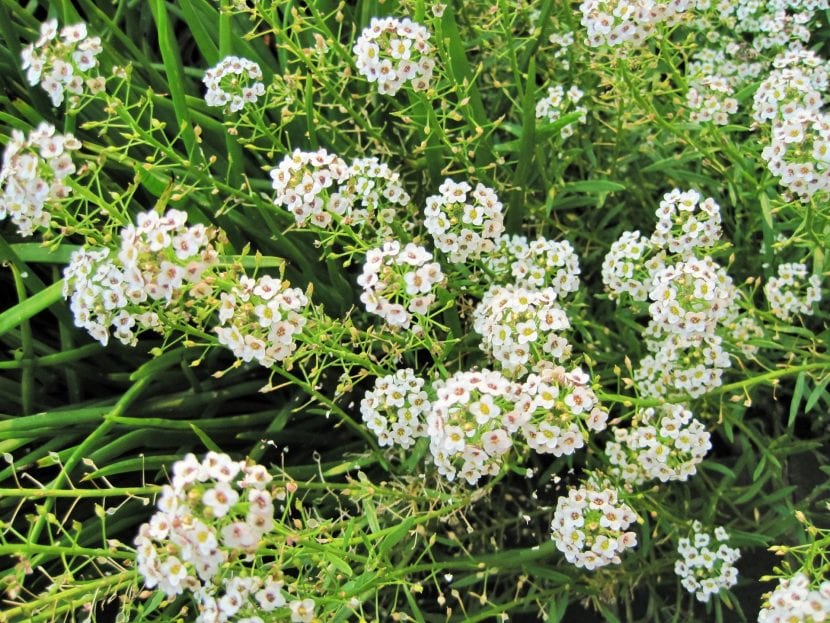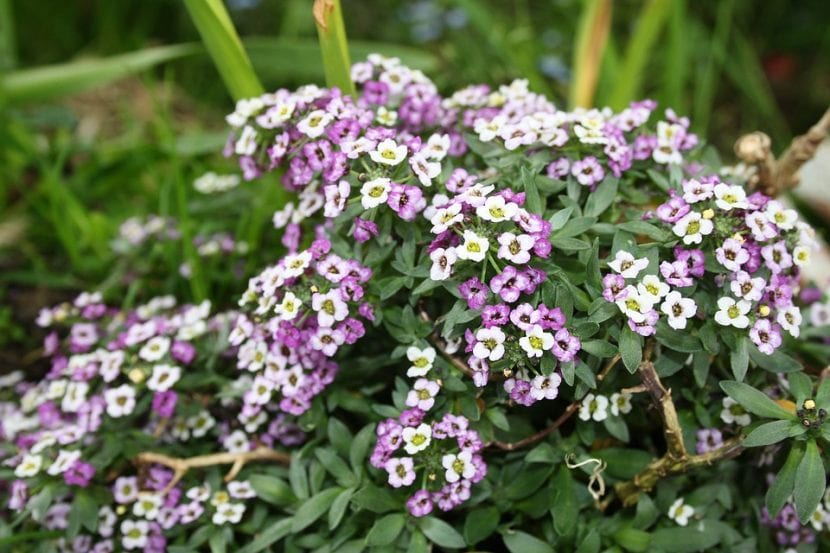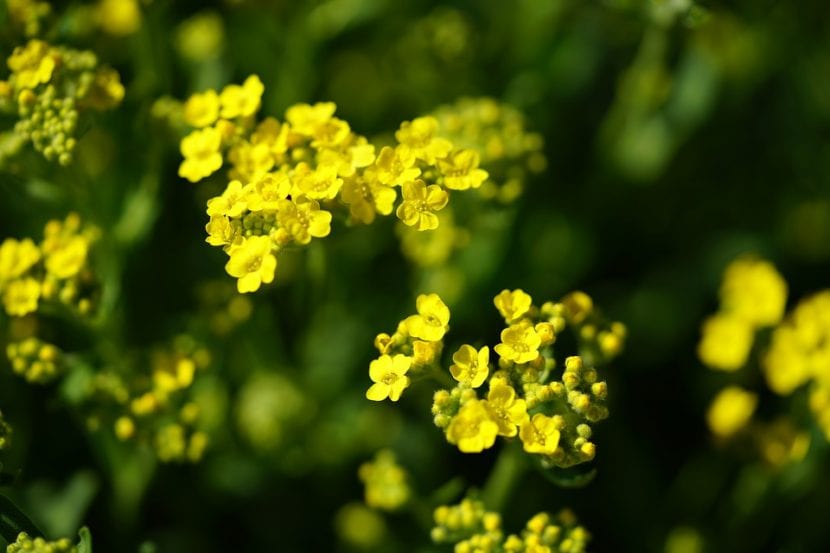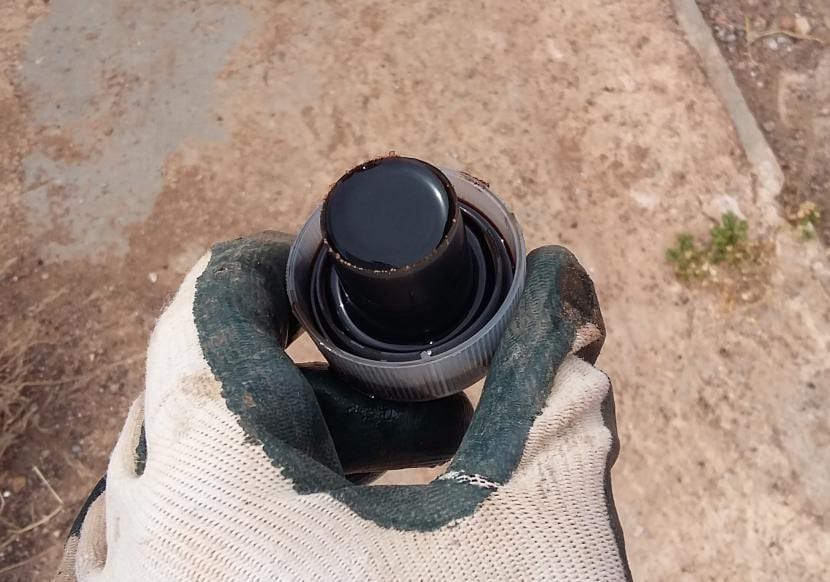
Plants of the genus Alyssum They are very interesting for gardens, especially when you see that you have very few empty spaces left; although they can also be grown in pots. And it is that its size is small, and its flowers ... its flowers are wonderful! 😉
Knowing its characteristics and its care will be very useful to know where you should put your copies. So here you have its complete file.
Origin and characteristics

The Alyssum are a genus of about 170 species of annual or annual plants, herbaceous or rarely low-rise shrubs, growing between 10 and 100cm. They are native to Europe, Asia and North Africa, found mainly in the Mediterranean region. The leaves are oblong ovoid, and produce yellow, white, pink or purple flowers.
Species
The main species are:
- Alyssum serpyllifolium: it is endemic to Algeria, Morocco, France, Portugal and Spain. It is a perennial, woody herb that produces yellow flowers. Its maximum height is 30-35cm.
- Alyssum garnatense: it is a plant known as a golden spikelet native to the center and south of the Iberian Peninsula. It grows between 5 and 12cm tall, and produces light-yellow flowers.
El Alyssum maritimum is the ancient scientific name of the lobularia maritima, also known as sea alder or sweet alyssum. It is an annual or perennial plant depending on the climate, which reaches 30 centimeters in height and produces white or purple flowers. It is native to the Mediterranean region and Macaronesia, and is used as a medicinal plant for being a diuretic and for helping to eliminate kidney stones.
What are their cares?
If you want to have a specimen of alder, we recommend providing it with the following care:
Location
It has to be placed abroad, full sun.
Earth

- Flower pot: being very adaptable, you can use universal growing medium without problem. But if you want, mix 50% mulch + 30% perlite + 20% worm castings.
- Garden: grows in all types of soils, as long as they are neutral to clayey and have good drainage.
Irrigation
Irrigation is one of the hardest tasks to master. When they also tell you that it is much easier to lose a plant if you water it excessively, what usually happens is that we water ... but little. And that's not good either. So, to get your Alyssum to grow well, you need to know when to water it.
During the summer, as it is usually a very hot and dry season in many places, you will have to water very often, but the rest of the year not so much. So that there is no room for doubt, the most advisable thing is to check the humidity of the earth, for example with a digital humidity meter, or by inserting a thin wooden stick (if it comes out practically clean when you extract it, water; otherwise, don't water).
Subscriber

Liquid guano
If it is planted in the garden, it is not necessary to fertilize it; instead, If you have it in a pot, I advise you to pay it once a month with organic fertilizers, how can he be guano (liquid) what can you get here. Do not forget to follow the instructions specified on the packaging since, although it is natural, there is a risk of overdose as it is highly concentrated.
Multiplication
The Alysssum multiplies by seeds in spring and shrub species also by cuttings after flowering. Let's see how to proceed in each case:
Seeds
- The first thing to do is fill a seedbed (like this one from here) with universal culture substrate.
- Then, the seeds are sown, placing a maximum of two in each socket.
- They are then covered with a thin layer of substrate.
- Finally, it is watered and placed outside, in full sun.
This way they will germinate in 2 or 3 weeks.
Cuttings
When the flowers have withered, cut a piece of about 30 centimeters, impregnate the base with rooting hormones or homemade rooting agents, and then plant it in a pot with vermiculite previously watered.
If all goes well, it will emit its own roots after a month.
Plagues and diseases
It is a plant very resistant to the usual pests and diseases, but if the growing conditions are not adequate it can be affected by mealybugs, aphids, and if it is watered in excess, by mushrooms. The first two are fought with potassium soap (for sale here) or diatomaceous earth (get it here), and the last with copper or sulfur in spring and autumn.
Pruning
Don't need it. Perhaps just cut the withered flowers and the dry leaves with scissors -for example, such as those for sewing, or children's ones- previously disinfected with pharmacy alcohol or a few drops of dishwasher and water.
Rusticity

It will depend on the species, but in principle they resist weak frosts of up to -7ºC.
What did you think of the Alyssum? Have you heard of this plant? If you dare to have a copy, enjoy it! 😉